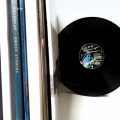Sick and tired of all that dirt, dust, and scratches getting in the way of your otherwise beautiful turntable? Want to learn how to restore a turntable dust cover to its former glory?
Then step forth and see as we show you the step-by-step process of restoring a dust cover with minimal supplies.
Table of Contents
- Step 1: Remove the Dust Cover
- Step 2: Cleaning Mixture
- Step 3: Submerge the Cloth
- Step 4: Wipe Surface
- Step 5: Clean Down
- Step 6: Drying
- Step 7: Polishing
- Final Tones
- FAQs How to Restore a Turntable Dust Cover

Step 1: Remove the Dust Cover
This step is one of the least obligatory in this process. Turntable dust covers are usually a little finicky, so it is advisable to leave the dust cover. At the same time, it is attached to the record player, so it is understandable that you should desire to remove the dust cover.
Removing the turntable’s dust cover with extreme trepidation and care will ensure that you do not do damage to the usually tender and delicate hinges that keep it in place.
If cleaning the stylus is important, then so is the dust cover.
Step 2: Cleaning Mixture
Next up, you will want to create the cleaning mixture you will use. Of course, elbow grease is one of the most important chemicals you will be using, but the actual solution that you use will determine just how deep a clean you can do with the tools you have.
Mix two cups of warm water with a quarter of a tablespoon of washing-up liquid and then mix them together until they have formed enough of a lather. These measurements are by no means strict and can be messed with depending on your taste. This, however, has proven most effective for us.
Step 3: Submerge the Cloth
After creating the mixture, submerge your cloth in the solution. We recommend using a microfiber cloth to ensure there is little to no interference from outside elements.
Submerge the microfiber cloth after you have placed the container of the solution on a flat surface to avoid spillages of any kind. Continue submerging until the cloth is damp. It should not be soaked through, so if you have accidentally done so, proceed to squeeze out the moisture until it is only damp. That being said, it should still be moist enough.
Step 4: Wipe Surface
Now that you have submerged your cloth in the appropriate solution until it is readily damp, you can proceed to wipe the entire surface from top to bottom. Completely wipe that thing to within an inch of its life.
If the cloth gets dry at any point, do not be afraid to resubmerge it into the solution. In this way, you should have this solution readily available and to hand. This will not only remove the dirt and dust that the cloth has accrued while cleaning the dust cover but also prevent this dirt from scratching or otherwise harming the dust cover.
Step 5: Clean Down
So, once you have made sure to wipe and clean every single surface on the dust cover, you can proceed to ensure that you have removed all of the residues that the cloth and the solution might have left behind.
To do this, you should ideally use a separate microfiber cloth and submerge it in plain water of a similar temperature until it is as damp as the original microfiber cloth. Wipe off the residue, give the plastic polish, and remove scratches (even deeper scratches) with overlapping circles.
Step 6: Drying
So, once you have followed the whole process up to this point meticulously, you can leave the dust cover to dry. It is imperative that you leave the dust cover to dry at this point and especially before carrying out the final step.
You can perform this drying process yourself by hand, though it is really best to let the dust cover dry naturally by being exposed to air. If the weather is fine, you could even leave it outside, though try to avoid doing so when the weather is warm and if exposed to direct sunlight, as this can have a devastating effect on plastic.
Step 7: Polishing
The final part of the process of cleaning a vinyl record is another one that, while not necessarily necessary, will certainly have your dust cover looking beautiful.
Once the dust cover is dry, apply some plastic to the entire surface of the dust cover in overlapping circles. Again, it is advisable that you use another separate microfiber cloth for this part of the process to ensure the best results. Avoid submerging the microfiber cloth this time – you will only want to get it wet.
If done correctly, your dust cover will be looking as new as it did when you first bought it.
Why not get your vinyl lover a great gift and buy them some polish?
Final Tones
So, there you have it! Hopefully, you are now feeling ready and prepared to be stomped into the ground with this knowledge.
FAQs How to Restore a Turntable Dust Cover
How do you buff a turntable dust cover?
There is no single method for doing so. Some suggest using toothpaste to remove oxidation and to further mitigate deeper hazing and scratches on a dust cover.
How do you clean dust covers?
You can, more often than not, clean dust covers with things you have lying around the house. All you will really need is some microfiber cloths and some washing-up liquid. Once you have created a cleaning solution with 2 cups of warm water and a quarter of a tablespoon of detergent, then you can proceed accordingly.
How do you get scratches out of a record player lid?
One of the premier methods for removing deeper scratches and wear from a record player lid is the use of toothpaste. Certain chemicals within are known to oxidize and clean away these kinds of scratches.
Do turntables sound better without dust cover?
This remains to be seen. No doubt there are plenty of audiophiles who would argue that it does, though equally, these are the kinds of people who have relatively few friends and are slowly alienating what few friends they have by being obtusely anal about sounds like so.





